Approximately two hundred spider species have made their home in Hawaii, though you will never encounter all of them. Some are more common than others, which is why we have listed the most common spiders you may encounter in Hawaii from the most popular to the least popular.
The common spiders in Hawaii include:
Table of Contents
1. Hawaiian Garden Spider
Scientific name: Argiope appensa.
Common name: Hawaiian garden spider, banana spider.

The Hawaiian garden spider is a member of the orb weaver family, which has been introduced to all the main islands in Hawaii. These spiders make a range of habitats their home from coastal areas to forests.
The females are more colorful and larger than the male. Females are black and yellow and grow to 2.5 inches (6.4cm) including the legs. Males, on the other hand, are brown in color and only grow to 0.75 inches (1.9cm).
They are sometimes referred to as banana spiders.
2. Asian Spinybacked Orbweaver

Scientific name: Thelacantha brevispina.
Common name: Asian spinybacked orbweaver.
The Asian spinybacked orbweaver was first described in 1882 and was introduced to Hawaii. They are small spiders with the females growing to 0.39 inches (10mm) in body length and males to 0.20 inches (5mm) in body length.
The females have six spines with sharp points on their abdomen with two white spots. Both the male and female have black, white, and brown mottling. Males do not have sharp spines on their backs. It is believed that the spines deter predators, making them unappealing as prey.
3. Pantropical Huntsman Spider

Scientific name: Heteropoda venatoria.
Common name: giant crab spider, cane spider, Pantropical huntsman spider.
The Pantropical huntsman spider, also known as a giant crab spider and banana spider, is often mistaken as a brown recluse (violin spider). These are large spiders that are brown in color with flattened bodies.
Their bodies grow to around an inch (2.8cm) with a leg span of up to 5 inches (12cm). The female body is larger than the male, but males have longer legs.
The females have a tan band, which encircles the carapace, while males have a cream band. The males also have a dark stripe on their abdomen and a pale area just behind the eyes.
These spiders are excellent at eradicating pest insects, especially cockroaches. They are fast with strong jaws and hunt their prey rather than relying on a web. They are common in homes, sheds, and barns where they hunt at night.
4. Spinybacked Orbweaver
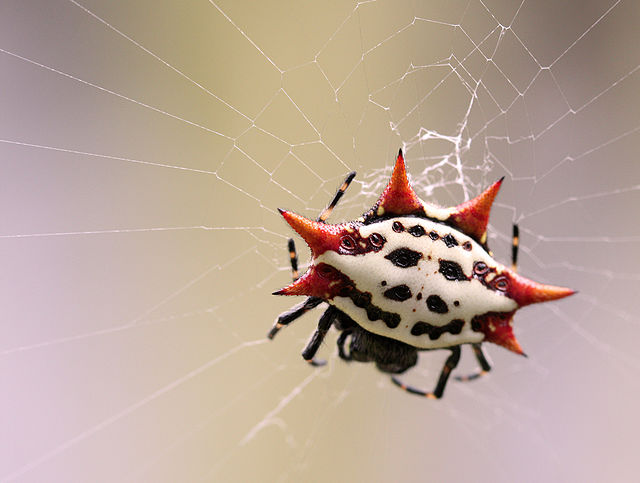
Scientific name: Gasteracantha cancriformis.
Common name: spinybacked orbweaver.
The spiny back orbweaver is a bright-colored orb weaver spider, able to create webs up to two feet in diameter. The females have six spines on their wide and hard abdomens. The male is considerably smaller than the female and does not have spines and lacks bright colors.
They are common in forests and back yards, but the good news is that they are not dangerous to humans and a bite is not considered a medical emergency.
5. Gray Wall Jumping Spider

Scientific name: Menemerus bivittatus.
Common name: Gray Wall Jumping Spider.
The gray wall jumping spider belongs to the Salticidae family, commonly encountered in the walls of buildings and on tree trunks.
These ambush predators do not rely on webs to capture prey, but use their excellent sight and jumping abilities to capture prey and escape predators.
This spider has short gray to white hairs on the body with dark brown tufts near its large eyes. Females grow to 9mm with males being smaller.
Males have a dark stripe with a white to brown stripe on the sides of their abdomen. Females are lighter in color, often more brown in color with a larger abdomen and carapace. The female has a wide black stripe on her sides and two bands with a white stripe on her carapace. Both have banding on their legs.
6. Banded Garden Spider

Scientific name: Argiope trifasciata.
Common name: banded garden spider, banded orb weaving spider.
Banded garden spiders are members of the orb weaver family, known for their large webs, which can reach 60cm in diameter. They spin their webs between bushes and stems. The female sits upside down in the center of the web, arranging her legs in pairs to make a cross shape.
The male is smaller than the female and creates small webs close to where the females are. They eat what gets caught in their web, including wasps.
7. Adanson’s House Jumper

Scientific name: Hasarius adansoni.
Common name: Adanson’s house jumper.
The Adanson’s house jumper is common in Hawaii with females growing to 8mm in body length and males growing to 6mm.
The males are black with a red mask and partially white pedipalps. There is a white crescent on their abdomen and two small dots on the rear. Females, on the other hand, are slightly larger, usually dark brown.
They create webs at night, though they are ambush predators, using their outstanding jumping abilities to capture prey and escape predators.
8. Common Web-Spider

Scientific name: Neoscona theisi.
Common name: Common web-spider.
Common web spiders belong to the Araneidae family with a body length of up to 0.43 inches (11mm). Males are smaller than females, growing to 0.35 inches (9mm). They create circular or orb webs, with the spider sitting in the center.
Their colors vary from a pale yellow to a red-brown with a pattern on the abdomen, which is light I the center and darker on the sides. They have light-colored legs with darker patches at the joints.
9. Cosmopolitan Jumping Spider

Scientific name: Ascyltus pterygodes.
Common name: Cosmopolitan Jumping Spider.
This jumping spider belongs to the Ascyltus genus, which is a group of large-sized jumping spiders with an unknown population density.
These spiders have iridescent scales on the carapace and large cheek areas with chelicerae, which are distended forwards. They have three rows of eyes with excellent eyesight.
As with all other jumping spiders, the cosmopolitan jumping spider is harmless and will only bite if provoked, which causes a localized stinging, similar to that of a bee or wasp.
10. Hawaiian Happyface Spider

Scientific name: Theridion grallator.
Common name: Hawaiian happy-face spider.
The Hawaiian happyface spider lives on the Hawaiian islands with a pattern on its abdomen that resembles a smiling face. They vary in color and often change their color based on their diet.
These small spiders grow no larger than 5mm in body length with long legs and a yellow body. The abdomen is a translucent yellow with black, red, or white patterns. The pattern on their backs varies from one island to the next with some having a vivid smiling face on a yellow body and others having no pattern.
They peer moist environments, those with an annual rainfall of up to 350cm per annum and are common in the Hawaiian forests, where they hide under the leaves of plants.
11. Ant-Mimicking Jumping Spider
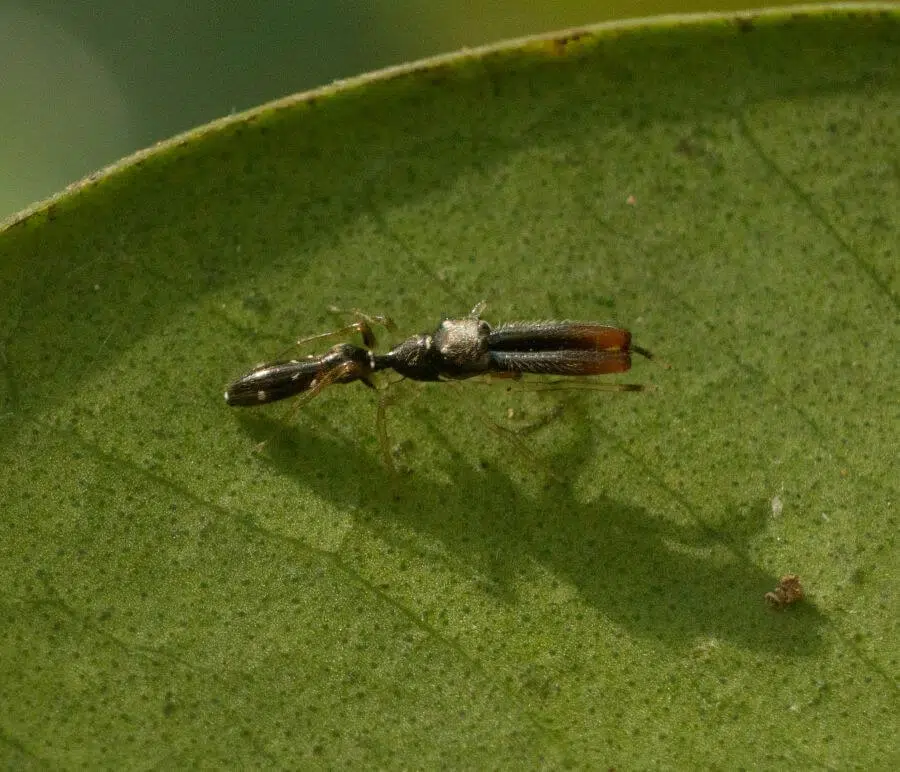
Scientific name: Myrmarachne nigella.
Common name: Ant-Mimicking Jumping Spider.
The ant-mimicking jumping spider was first described in 1839 and has undergone a number of changes.
They have an elongated cephalothorax (headspace), long chelicerae, and a range in color. The cephalothorax has a waist and they can range from black to yellow, depending on the type of ant the spider is mimicking. These spiders wave their front legs in the air, making them look like antennae with a body that looks very much like an ant.
Further Reading:
12. Orchard Spiders

Scientific name: genus Leucauge.
Common name: Orchard spiders.
The orchard spider is a long-jawed orbweaver, which was first documented in 1841. The body and legs are silver, black and yellow in females with two rows of slender hairs on the femur of the fourth leg.
They create slanted webs with the female sitting in the middle facing upside-down waiting for prey to get entangled. Males are smaller than females and tend to hide close to the females.
13. False Black Widow

Scientific name: Steatoda grossa.
Common name: cupboard spider, dark comb-footed spider, brown house spider, false widow, false black widow.
The false black widow is also known as the cupboard spider and is often confused as a black widow. The females have bulb-shaped abdomen and are dark in color, growing up to 10.5mm in body length.
Their colors range from purple-brown to black with light-colored markings, which helps you differentiate them from the black widow. The false black widow does not have a red hourglass pattern or any bright marking on the belly.
Males are thinner and smaller than females, growing to 10mm in body length. The males and females are similar in color, but the males are lighter with red coloration on their legs.
The false black widow creates a cobweb, which is a messy tangle of sticky silk, which they rely on to capture their prey. They have poor eyesight, relying on vibrations within the web to help them identify when prey is entangled.
They are not aggressive towards humans with most bites being defensive. While their bites are considered medically significant, they are minor and don’t have any lasting effects.
The symptoms of a false widow bite include blisters at the bite site, pain, muscle spasms, fever, and sweating, which lasts a few days.
14. Trashline Orbweavers

Scientific name: genus Cyclosa.
Common name: trashline orbweavers.
The trashline orbweaver was first described in 1866 and is widely distributed. They create small orb webs with decoration, which includes debris and prey remains, eloping to camouflage the spider.
Unlike the other orbweavers, which hang upside down in the center of their webs, the trashline orbweaver faces upwards. They create two webs, a sticky web, and a resting web. They rely on the vibrations of the web to tell them when they have prey entangled. They are known to bounce in their webs, making themselves blurry to predators and prey.
15. Ninja-star Ceiling Spider

Scientific name: Zosis geniculata.
Common name: humped spider, grey house spider.
The ninja star ceiling spider is also known as the humped spider and is a cosmopolitan spider species, often encountered in outbuildings, such as barns, garages, and sheds.
16. Tetragnatha quasimodo
The tetragnatha quasimodo spider is one of the most beautiful species in Hawaii, though they remain largely undocumented. They have a long abdomen that is black on a light brown body, their cephalothorax is brown with black and brown banding on the legs.
17. Long-bodied Cellar Spider

Scientific name: Pholcus phalangioides.
Common name: daddy long-legs spider, long-bodied cellar spider, skull spider.
The long-bodied cellar spider has an elongated and tubular shape to the abdomen with a rounded bottom and tapered waist. With long and spindly legs, they have often allied a Daddy Long Legs.
They tend to bounce in their web, making it harder to see them. This disorientates predators. They hang upside-down waiting for insects to get entangled in their webs. They have bad eyesight, relying on vibrations within the web.
Their small mouthparts make it difficult to bite humans, their short fangs are too small to inject venom.
18. Striped Lynx Spider

Scientific name: Oxyopes salticus.
Common name: striped lynx spider.
Striped lynx spiders were first described in 1845, where they tend to live in leafy vegetation, weedy fields, crops, and grass. Adults range from orange, cream, and brown. Females have stripes on their abdomens and carapace with the stripes being more pronounced on the abdomen. They have a diamond cardiac mark. Females are larger than males, growing to 6mm in body length, while males grow to around 5mm in body length.
These spiders are found in great numbers in the Big Island of Hawaii.
19. Western Spotted Orbweaver

Scientific name: Neoscona oaxacensis.
Common name: western spotted orbweaver, zig-zag spider.
The western spotted orbweaver belongs to the Araneidae family and is a large spider with females growing to 0.7 inches (18mm) in body length and males being on the smaller side, growing to 0.25 inches (6mm). They are black and white on their slender abdomen with a light central band, which has a wavy border.
As with all orbweavers, they can create large circular-shaped webs, which can span up to two feet in diameter, where the spider hangs upside down, waiting for prey to get entangled.
20. Lami Beach Northern Jumping Spider
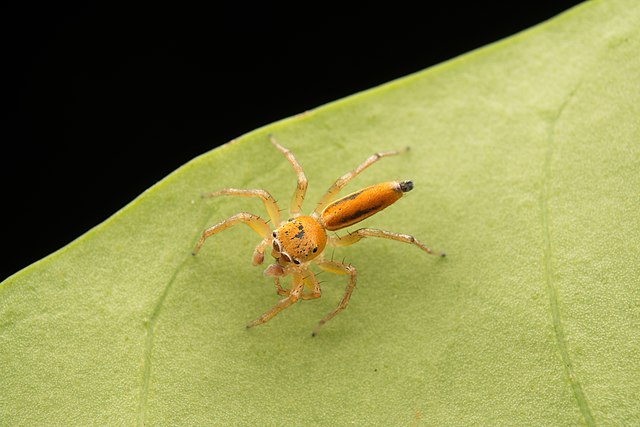
Scientific name: Cosmophasis lami.
Common name: Lami Beach northern jumping spider.
The Lami beach northern jumping spider was first described in 1997 with females being more colorful than the male, growing to 5.5mm. Males grow to around 4.5mm. The females have an orange to gold stripe down a cream abdomen, while males have an orange to red-colored headspace. Their eyes rearranged in four pairs of two.
21. Ariamnes waikula
Ariamnes waikula is native to Hawaii and is often found in wet forest habitats up to 3.500 feet above sea levels. They have gold-colored abdomens and were first described in 2007. These are also known as tangle web spiders, known for their messy webs that are sticky, capturing prey with ease.
22. Brown Widow

Scientific name: Latrodectus geometricus.
Common name: brown widow, brown button spider, grey widow, brown black widow, house button spider, geometric button spider.
The brown widow is also often called the brown button spider and is the cousin of the famous black widow. This spider has black and white patterns on the sides of the abdomen with an orange to yellow hourglass on the belly.
They do bite, which is exceptionally painful, but are not considered dangerous. They have a neurotoxic venom, which acts on the nerve endings, causing unpleasant symptoms. Their bites e not considered dangerous with the symptoms remaining confined to the bite area.
They are smaller and lighter than the black widow, ranging from tan to brown and even black, usually with shades of gray. They have banding on the legs and a black and white pattern on the rear of their abdomens.
23. Tetragnatha hawaiensis
This is a long-jawed spider that has gone through diversification in Hawaii with thirty-seven described species. This spider is an active hunter, using its web as a retreat, where it can hide and eat. There is very little information documented on this Hawaii spider species.
24. Yellow Garden Spider

Scientific name: Argiope aurantia.
Common name: yellow garden spider, black and yellow garden spider, golden garden spider, writing spider, zigzag spider, zipper spider, black and yellow argiope, corn spider, Steeler spider, McKinley spider.
Yellow garden spiders are also known as writing spiders. The legend says that if you damage or disturb their web, they will write your name when they reweave their web. This is a beautiful black and yellow spider that is not a poisonous and welcome addition to your garden. They create large circular webs out of strong silk, which they vibrate when they feel threatened.
They eat a range of insects, including flies, mosquitoes, and gnats. The spider injects venom into the prey and wraps it in a silk web, leaving it until the prey liquefies. The spider then drinks the fluid.
They are not an aggressive species, but they will bite if provoked, which can be compared to a bee sting, along with swelling and redness in the bite area.
They are not a problem for healthy adults, though they can cause a reaction in the elderly, young children, and those with compromised immune systems.
25. Common House Spider
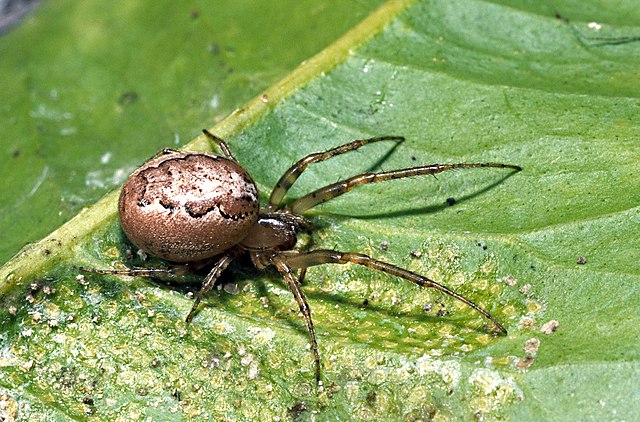
Scientific name: Parasteatoda tepidariorum.
Common name: common house spider, American house spider.
Common houses spiders are the spiders that create the common cobweb, that is used on Halloween and in horror movies. They are always found in or near human dwellings.
They rely on their webs to capture prey, relying on the vibrations in the web to help them detect the prey, which is then paralyzed with the spider’s venom.
These spiders vary in color from black to tan, usually with different shade patterns on the body. Females are larger than the males, growing to 0.24 inches (6mm) in body length and males growing to 0.19 inches (4mm) in body length. Females have a bulb-shaped abdomen with the females being more on the slender side.
A bite from one of these spiders is not considered dangerous with pain and swelling subsiding with a day or two.
26. Pantropical Jumping Spider

Scientific name: Plexippus paykulli.
Common name: pantropical jumping spider.
Pantropical jumping spiders come from southeast Asia and have been introduced to Hawaii where they are usually found in or on buildings, where they use light sources to capture prey that is attracted to the light.
They are robust spiders with the ability to jump more than four times their body length. They are fast jumpers, which enables them to ambush prey and escape predators, including curious humans. These spiders have short gray hairs and the males have red accents.
Females are larger and grow to 0.47 inches (12mm), males o the other hand, grow to 0.43 inches (11mm). The males and females can be differentiated with males being black with a white central stripe and a white stripe on each side, along with two white spots on the back end of the abdomen. The female is brown to gray with the carapace being darker. They have a tan line that extends down the abdomen, separating into two chevrons. There are two white spots on both sides of the rear end of the abdomen. Juveniles resemble females.
27. Pale Daddy Longlegs Spider

Scientific name: Smeringopus pallidus.
Common name: pale daddy-long-leg.
The pale daddy longlegs belongs to the Smeringopus genus with the female being larger than the male. They grow to an average of 7mm in body length with an elongated and cylindrical-shaped abdomen with purple spots on their backs. They have a dark stripe on the sternum and have no spines on their legs.
They build irregular-shaped cobwebs in dark corners of the house, where they capture small insects and small spiders. The spider will hang upside down in the web and vibrate it vigorously if disturbed and confuse any predators.
28. Messua felix
The Messau felix is a jumping spider and a member of the Messua genus, which was first described in 1901.
These spiders are able to jump incredible distances in rapid-fire motion, which they use to ambush prey and escape predators. They ambush their prey, capturing them and biting them, before dragging the prey back to their webbed retreat, where they can eat in privacy and safety.
Their bites are not considered dangerous but can be painful with some localized redness and swelling.
29. Hogna hawaiiensis
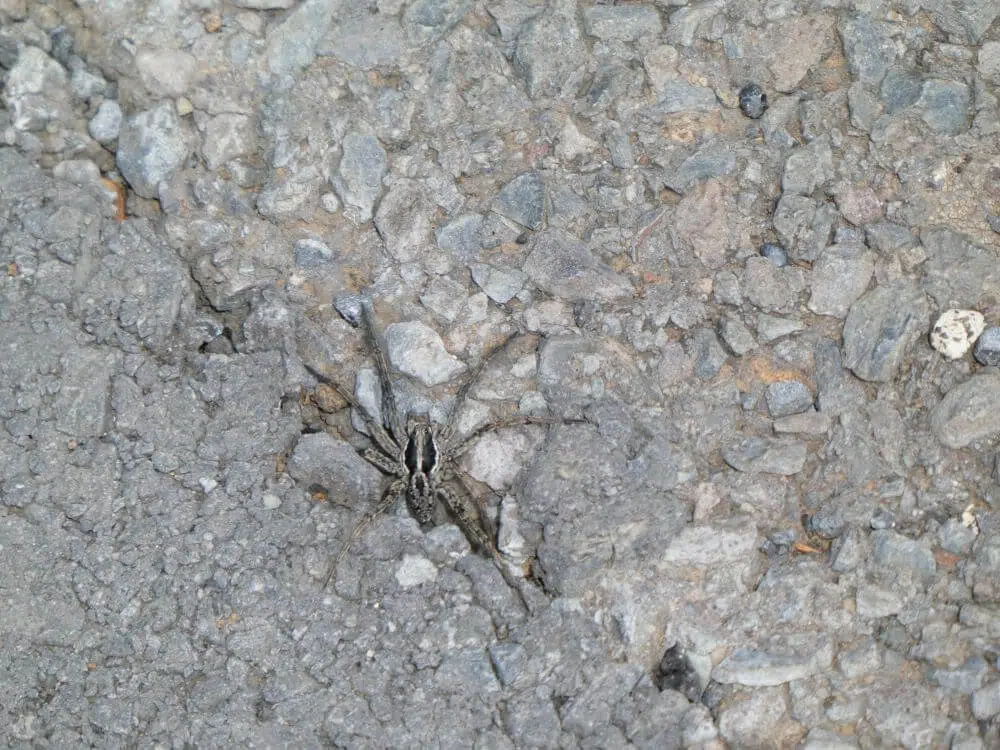
The Hogna hawaiiensis is a wolf spider that is an excellent and fast ambush predator.
They are large spiders that range from 0.87 inches to 4.7 inches (2.2cm to 12cm) in body length with the female being larger than the male. They are brown with some body patterns and long legs.
The female Hogna hawaiiensis is an excellent parent and surrounds her oval eggs in a webbed sac until the spiderlings hatch. Once hatched, the babies remain with the mother, clinging to her body and legs until they can fend for themselves.
They do not make webs, their silk is to protect eggs and create a door to their burrow, which they make underground.
A bite from the Hogna hawaiiensis is not deadly but will cause mild to moderate pain, swelling and redness.